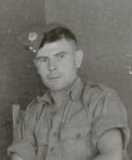Loughor, or Llwchwr, is a town in the City and County of Swansea, just within the county boundary of Glamorgan, on the estuary of the River Loughor and adjoins the edge of Carmarthen County. The town was home to Leucarum Roman fort, the foundations of which were used to build Loughor Castle in 1106. The town of Loughor developed around the castle, and became a thriving port. The war memorial to the men of Loughor who fell during the Great War is located on a roundabout in Upper Loughor, which was unveiled by Vice Admiral Heneage-Vivian on 14 May 1927, and takes the form of an obelisk. There are no names on the memorial, so the details below have been made up of men known to have either been born or have resided in Loughor. St. Michael’s Church contains a memorial to two local men who fell during the Boer War of 1899 to 1902. There is also a wooden memorial plaque in the town to those who fell in both WW1 and WW2, but many names appear to be missing. As a result all those who I have found to have had links to the town, either through birth, residence or family ties, are shown on this page.
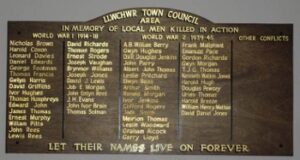
The Boer War, 1899-1902
SACRED TO THE MEMORY OF PTE. WILLIAM HAMMOND AND PTE. WILLIAM JOHN EVANS 1ST WELSH REGIMENT BOTH OF THIS BOROUGH WHO DIED WHILE ON ACTIVE SERVICE SOUTH AFRICA, 1900. THIS TABLET WAS ERECTED BY THE INHABITANTS OF LOUGHOR, AS A MARK OF APPRECIATION OF THEIR SERVICES RENDERED TO THEIR COUNTRY 1904. “AND THERE WAS NO MORE WAR”
William John Evans, Private, 6399, Welsh Regiment. William was posted to South Africa with the 1st Battalion, Welsh Regiment after the outbreak of the Boer War. He was probably killed at Bloemfontein on 2 May 1900.
William Hammond, Private, 5676, Welsh Regiment. William was born in Brynmawr, Breconshire in 1877. By 1891 he was living with his Aunt, Esther Hughes, at Loughor Schoolhouse, who had adopted him, and worked as a blacksmith’s striker at the Gorseinon Steelworks. He was already a member of the local Volunteer Battalion of the Welsh Regiment when he enlisted into the Welsh Regiment as a regular soldier in 1898, and was posted to South Africa with the 1st Battalion, Welsh Regiment after the outbreak of the Boer War. He was killed at Paardeberg on 18 February 1900, aged 23.
The Great War, 1914-1918
Richard Llewellyn Bailey, Driver, T/145, Royal Army Service Corps. Richard was the son of William and Elizabeth Bailey. He married Sarah Elizabeth Glover in 1910, and the couple lived at 5 Winston Street, North Hill Road, Swansea. He joined the TA in Swansea in November 1912, and attended two Territorial Camps at Llandeilo and Penally prior to the war. He was on home service when war erupted, and in February 1915 took ill. He was discharged from the army in June 1915, suffering from endocarditis, and died is Swansea on 7 January 1919, aged 32. He is buried in Swansea (Danygraig) Cemetery. His widow Sarah married Manfred James Ley, of 14, Yspitty row, Loughor, in 1920, and died in 1978, aged 90. Richard is not commemorated on the Loughor War Memorial.
John Ivor Brain, Sapper, 151355, Royal Engineers. John was born in 1893, the son of John and Margaret Brain, of 6, Prospect Terrace, Mason Road, Gorseinon. He worked at Gorseinon Sheet Mills prior to enlisting at Swansea into the Somerset Light Infantry on 1 September 1914. He subsequently transferred to the Devonshire Regiment and served in France with their 2nd and 1st Battalions before being wounded by a bullet in his leg and after recovering was transferred to the 253rd Tunnelling Company, Royal Engineers on 15 November 1915. John was killed by a direct hit from a shell whilst working near Vermelles on 27 April 1916. He was 23 years old and is buried in Vermelles British Cemetery, France.

Nicholas Brown, Rifleman, C/908, King’s Royal Rifle Corps. Nicholas was born in Loughor, the son of George and Mary Ann Brown. The family later moved to Gowerton, where Nicholas worked in the steel industry. He enlisted in Swansea into the King’s Royal Rifle Corps in October 1914, and was posted to the 16th (Service) Battalion (Church Lads Brigade). Nicholas landed at Le Havre with the battalion on 17 November 1915, which then moved to join 100 Brigade, 33rd Division in the Loos sector for trench initiation. Nicholas was killed here on 27 June 1916, just prior to the divisions move south to the Somme. He was 20 years old and is buried in Cambrin Military Cemetery, France.
Thomas Bull, Private, 12869, Royal Welsh Fusiliers. Thomas was the son of Thomas Samuel and Emily Jane Bull, of Culford Road, Loughor. He worked at St. David’s Tinplate Works prior to enlisting at Llanelli at the start of the war into the 8th Battalion, Royal Welsh Fusiliers. The battalion was attached to 40 Brigade, 13th (Western) Division, and landed at Gallipoli on 6 July 1915. It remained there for the remainder of the campaign, seeing terrible fighting during its first weeks there. By January 1916 the division had moved to defend the Helles bridgehead, becoming almost the last troops on the peninsula. Thomas was killed in action on 7 January 1916, aged 16, just a day before the battalion was evacuated. He is buried in Pink Farm Cemetery, Helles. Thomas is not commemorated on the Loughor War Memorial.
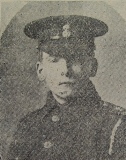
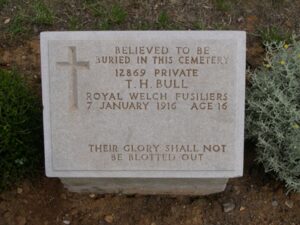
Walter Camp, Private, G/21235, Royal West Kent Regiment. Walter was born in Loughor, the son of John and Dina Camp. The family later moved to Pwll, and Walter enlisted at Llanelli on 11 May 1916 into the Monmouth Regiment. He was posted to France on 23 September 1917, and joined the 10th Battalion, Royal West Kent Regiment, which was attached to 123 Brigade, 41st Division. The Division was selected as one of five British Divisions to be moved to Italy, as part of a reinforcement action taken by the Allies following a disastrous defeat of the Italian Army at Caporetto. The Company arrived at Mantua on 17 November 1917, where they held a part of the line on the River Piave, however, the crisis had passed and the Division was hurried back to the Western Front in early March 1918. They then faced the German Spring Offensive of 21 March 1918, and fought at the Battle of St Quentin, and retreated westwards, fighting at the First Battle of Bapaume. They also then fought at the First Battle of Arras, before being withdrawn, and sent north to Flanders where it held a sector near Ypres that was, for once, relatively quiet. Here they took part in the Advance in Flanders, and the Battle of Ypres 1918, before moving on to fight at the Battle of Courtrai, and the subsequent Action of Ooteghem. Walter was wounded during these final actions of the war, and was evacuated to the 2nd Australian Hospital at Wimereux, where he sadly died of wounds on 19 November 1918, aged 20. He is buried at Terlincthun British Cemetery, Wimille, France. Walter is not commemorated on the Loughor War Memorial.
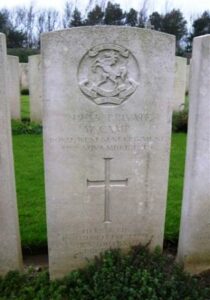
Harold Victor Coxon, Private, 58393, Royal Welsh Fusiliers. Harold was born at Headley, Hampshire, the son of John Shield and Leah Annie Coxon. By 1911 the family had moved to The Woodlands, Loughor. Harold enlisted at Swansea into the South Wales Borderers, and was posted to the 16th Battalion, Royal Welsh Fusiliers, which was attached to 113 Brigade, 38th (Welsh) Division. He would have joined the battalion at some time early in 1918, some months after the division’s assault on Pilckem Ridge on 31 July 1917. The division moved to the Somme sector in March 1918, and took up positions north of Albert, facing the Germans across the Ancre valley. It launched its offensive across the Ancre on 21 August 1918, before beginning its part in the great advance to victory, and over the coming weeks pushed the Germans back, crossing the Canal du Nord and the Hindenburg Line in October. The 38th Welsh Division then advanced towards the Forest of Mormal, past the old 1914 battlefields of Le Cateau. Harold was killed in action during fighting on the outskirts of the forest on 4 November 1918, aged 19. He is buried in Englefontaine British Cemetery, France.
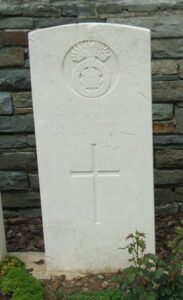
David Davies, Lance Bombardier, W/5135, Royal Field Artillery. David was the son of Jane Davies, of 4, Yspitty Row, Loughor. He enlisted at Swansea into the Welsh Field Artillery, and landed in France on 24 December 1915 attached to D Battery, 121st Brigade, Royal Field Artillery, which was attached to the 38th (Welsh) Division. He fought on the Western Front with the division for the duration of war, seeing action at Mametz Wood in 1916 and at Pilckem Ridge the following year. He also survived the divisions part in the great offensive of 1918, but died, probably of influenza, in the former German Hospital at Caudry on 30 November 1918, aged 23. He is buried in Caudry British Cemetery, France. David is not commemorated on the Loughor War Memorial
Leonard Raymond Davies, Private, 1475, Welsh Regiment. Leonard was the son of James and Edith Davies, of 5, Rollers Row, Spitty, Llanelli. He lived at Loughor prior to the war and enlisted at Swansea into the 1/6th Battalion, Welsh Regiment. The battalion formed in the town in August 1914, and on 29 October 1914 landed at Le Havre and moved to work on Lines of Communication. On 5 July 1915 it came under orders of 84 Brigade, 28th Division, then on 23 October 1915 transferred to 3 Brigade, 1st Division, before finally becoming the Pioneer Battalion to the 1st Division on 15 May 1916. The division moved to the Somme from the Loos sector in June 1916, and took part in the Battle of Pozières, seeing heavy fighting around Munster Alley. Leonard was badly wounded on the Somme, and died on 26 July 1916 aged 20. He is buried in Daours Communal Cemetery Extension, France.
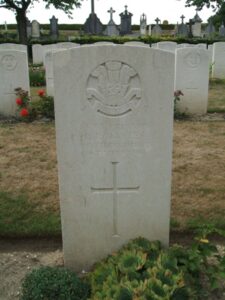
Daniel John Edwards, Private, 82799, Machine Gun Corps. Daniel was the son of John and Ann Edwards, of Bridge Road, Loughor. He married Lizzie Adeline Williams, of Bynea, in 1916, just after enlisting into the 3rd Battalion, South Wales Borderers. He was posted to the Machine Gun Corps on 27 December 1916, and on 25 May 1917 was posted to France, joining the 24th Company, Machine Gun Corps, which was attached to the 8th Division. In March 1917 the division followed the German Retreat to the Hindenburg Line, and later that year moved to Ypres. Daniel was killed at Ypres on 21 June 1917, aged 23. He is buried in Wulverghem-Lindenhoek Road Military Cemetery, Belgium.
John Henry Evans, Private, 292314, Royal Welsh Fusiliers. John was the son of Jane Evans, of 428, Pant Terrace, Garden Village, Gorseinon. He enlisted at Gorseinon on 11 December 1915 into the 4th Reserve Battalion, Royal Welsh Fusiliers, and landed in France on 16 July 1917, joining the 14th Battalion, Royal Welsh Fusiliers, which was attached to 113 Brigade, 38th (Welsh) Division. He joined the division in time to take part in its attack on Pilckem Ridge on 31 July 1917. The 15th Welsh remained in the line, and also took part in the Battle of Langemarck, before the entire Division was moved to positions near Armentieres over the winter. After the Germans launched their offensive on the Somme on 21 March 1918, the Division was moved back to the Somme, and took up positions north of Albert, around Aveluy Wood. It remained here throughout the summer, until taking part in the launching of the 100 days offensive on 21 August 1918, driving across the River Ancre and capturing the heights of Thiepval Ridge, before advancing across the old Somme battlefields of 1916. John was killed when his battalion was fighting around the edges of Mametz Wood on 26 August 1918. He was 22 years old and is buried in Caterpillar Valley Cemetery, Longueval, France.
Robert Evans, Stoker 2nd Class, K/44216, Royal Navy. Robert was born on 13 August 1894, the son of Benjamin and Hannah Evans, of Cwmbwrla. He married Catherine Howells in 1915, probably just after joining the Royal Navy. Robert was posted aboard the Sharpshooter Class minesweeper HMS Seagull. On 30 September 1918 Seagull was operating off the west coast of Scotland when she collided with a merchant ship, and sank with the loss of 54 lives. Robert was 23 years old when he died that day, and is commemorated on the Plymouth Naval Memorial, Devon. He is not commemorated on the Loughor War Memorial
Charles John Footman, Private, 2359, Welsh Regiment. Charles was born in Pembroke Dock early in 1888, the son of John Charles and Sarah Footman (nee Davies), of the Duke of York Inn and Grocers Shop. The family later moved to 16, Trinity Street, Gorseinon, Swansea, after John got work there as a Foreman with a building company. Charles worked as a Fireman at the Grovesend Steelworks prior to the war, and enlisted at Swansea into the local Territorial battalion, the 1/6th Battalion, Welsh Regiment. The battalion was one of the first territorial units to move to France in August 1914. Initially, in late 1914 and early 1915, they were on lines of communication and in July 1915 were based near Locre and Kemmel area, facing the Germans who were on the high ground at Spanbroekmolen. The battalion was in the trenches, but also doing work repairing trenches etc. On the morning of 3 August 1915, Charles was sniped through the head whilst looking over the parapet. He died instantaneously and was buried that afternoon in the grounds of the nearby Lindenhoek Chateau. The cemetery is now known as Lindenhoek Chalet Military Cemetery, Belgium. His brother George was killed just five months later. Charles is not commemorated on the Loughor War Memorial, although George is.
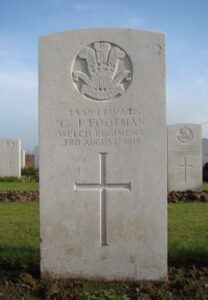
George Henry Footman, Sapper, 151337, Royal Engineers. George was born in Pembroke Dock on 16 June 1889, the son of John Charles and Sarah Footman (nee Davies), of the Duke of York Inn and Grocers Shop. The family later moved to 16, Trinity Street, Gorseinon, Swansea, after John got work there as a Foreman with a building company. George worked as a Collier prior to the war, and married Sarah Ann Roberts at Swansea on 20 July 1912, the couple taking up residence at 23, Garden Crescent, Garden Village, Gorseinon, where they raised two children. George enlisted into the 10th Battalion, Devonshire Regiment early in the war, moving to France on 23 September 1915, where the battalion was attached to 79 Brigade, 26th Division. Due to his mining skills, George was transferred into the 253rd Tunnelling Company, Royal Engineers, which formed in January 1916, at Sailly Labourse, moving to the front line areas of the old Loos battlefield, north of the Vermelles to Hulluch road. George was killed here on 19 January 1916, probably whilst working underground. He was 27 years old, and is commemorated on the Loos Memorial, France.
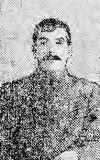
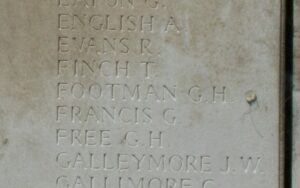
Thomas Francis, Private, 265309, Welsh Regiment. Thomas was the son of John and Sarah Francis, of Swansea Road, Loughor. He enlisted at Swansea into the 1/6th Battalion, Welsh Regiment. The battalion formed in the town in August 1914, and on 29 October 1914 landed at Le Havre and moved to work on Lines of Communication. On 5 July 1915 it came under orders of 84 Brigade, 28th Division, then on 23 October 1915 transferred to 3 Brigade, 1st Division, before finally becoming the Pioneer Battalion to the 1st Division on 15 May 1916. Thomas must have been invalided home at some point, and later in the war was transferred to the 4/5th Battalion, Welsh Regiment, which was in Palestine attached to the 53rd (Welsh) Division. He died on 6 November 1918, aged 24, and is buried in Alexandria (Hadra) War Memorial Cemetery, Egypt.
David Griffiths, Private, 50312, Welsh Regiment. David was born in Loughor, the son of David and Sarah Griffiths. The family later resided at 7, Rosser’s Terrace, Cilfrew, near Neath. He enlisted at Neath into the Welsh Regiment, and was posted to Egypt, joining the 24th (Pembroke and Glamorgan Yeomanry) Battalion, Welsh Regiment, which was attached to 231 Brigade, 74th (Yeomanry) Division. The Division had formed in Egypt in January 1917 and had fought through the Palestinian Campaign, at the Battles of Gaza. David was killed in action during the capture of Beersheba on 31 October 1917, aged 36. He is buried in Beersheba War Cemetery, Israel.
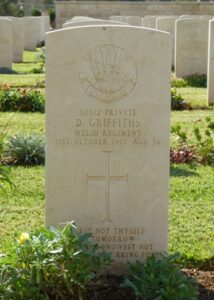
Martin Griffiths, Private, 13331, South Wales Borderers. Martin was the son of Anthony and Rebecca Griffiths, of 2, Bethania Terrace, Llanelli. He enlisted at Llanelli into the 4th Battalion, South Wales Borderers, which was attached to 40 Brigade, 13th (Western) Division. The Division fought at Gallipoli from July 1915 onwards, suffering heavy casualties over the coming months. Martin doesn’t look to have served overseas, but took ill, and died at Gloucester on 14 December 1915. He was 30 years old, and is buried at Loughor (St. Michael) Churchyard. Martin is not commemorated on the Loughor War Memorial.
Gwilym John Harries, Sergeant, 15031, Welsh Regiment. Gwilym was born at Llwynhendy in 1892, the son of William John and Ann Harries. He married Jessie Rees prior to 1911, and the couple resided at Loughor. Gwilym enlisted at Swansea into the 9th Battalion, Welsh Regiment, which was attached to 58 Brigade, 19th (Western) Division. The Division crossed to France during July 1915, and moved to positions near Loos, where it took part in the opening attack of the Battle of Loos on 25 September 1915. The following year the Division moved to the Somme, where it took part in the second wave of the attack on Ovillers-La Boisselle on 1 July 1916, capturing the village at heavy cost. It then fought through the Somme Battles of Pozières and the Ancre in 1916. In 1917 the Division moved north to Ypres, taking part in the Battle of Messines. Gwilym was wounded at Messines, and died of his wounds on 28 May 1917. He was 25 years old, and is buried at Bailleul Communal Cemetery Extension, France. Gwilym is not commemorated on the Loughor War Memorial.
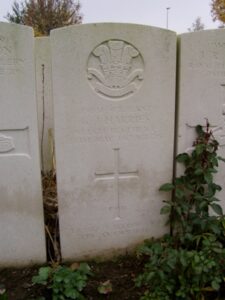
William Henry Hopkins, Private, 1885, Welsh Regiment. William was the son of David and Mary Hopkins of Bynea. His father died when he was young, and his mother remarried Thomas Williams, of 2, Pantyglien, Loughor. William enlisted at Gorseinon into the 1/6th Battalion, Welsh Regiment, the Glamorgan Territorial’s, which moved to France in October 1914, where it became Pioneer Battalion to the 1st Division. William fought with the Division at the Battle of Loos in September 1915, and they remained in the area over the coming winter. William was sheltering in a dugout when the ventilation shaft got blocked, and he suffocated, on 21 February 1916. He was 23 years old, and is buried at Maroc British Cemetery, Grenay, France, in Grave I. A. 40. William is not commemorated on the Loughor War Memorial.
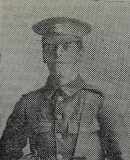
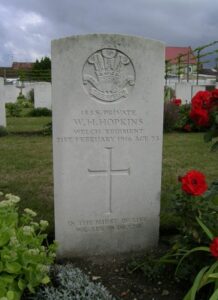
Edward George Housego, Private, CH/16971, Royal Marine Light Infantry. Edward was born in Wimbledon on 23 September 1879, the son of George William and Martha Matilda Housego. The family later moved to 13, Mountpool Avenue, Upper Loughor. Edward enlisted into the Royal Marines Light Infantry at some time prior to the war, and was posted aboard the armoured cruiser HMS Cressy. On 22 September 1914 Cressy was on patrol in the English Channel along with her sister ships Aboukir and Hogue, when all three ships were torpedoed and sunk by the German submarine U-9. Edward was among 560 men lost when Cressy sunk that day. He was 34 years old and is commemorated on the Chatham Naval Memorial, Kent. His brother Herbert also fell. Neither brother is commemorated on the Loughor War Memorial.
Herbert Housego, Private, 9888, East Surrey Regiment. Herbert was born in Wimbledon, the son of George William and Martha Matilda Housego. The family later resided at 13, Mountpool Avenue, Upper Loughor. He enlisted at Kingston on Thames into the 2nd Battalion, East Surrey Regiment. The battalion was in Chaubattia, India at the outbreak of war, and returned home, landing at Devonport on 23 December 1914, and joining 85 Brigade, 28th Division. The division landed at Le Havre on 19 January 1915, and moved to Flanders. The division saw its first major action during the Second Battle of Ypres the following month. Herbert was posted as missing, presumed dead, on 14 February 1915. He was 25 years old and is commemorated on the Ypres (Menin Gate) Memorial, Belgium. Soldier’s Died in the Great War shows 25 April 1915, but the former date is correct. Neither brother is commemorated on the Loughor War Memorial.
Ivor Hughes, Private, 19975, Royal Welsh Fusiliers. Ivor was the son of David and Ruth Hughes, of Emlyn House, Loughor. He enlisted at Swansea into one of the Royal Welsh Fusiliers battalions which was attached to the 38th (Welsh) Division, but was posted to the 9th Battalion, Royal Welsh Fusiliers, which was attached to 58 Brigade, 19th (Western) Division. The battalion moved to France on 18 July 1915, and moved with the division to positions near Loos, where it took part in the opening attack of the Battle of Loos on 25 September 1915. Ivor was badly wounded during the build up to the Loos offensive, and died on 24 September 1915, aged 18. He is buried in Brown’s Road Military Cemetery, Festubert, France. On the following day the 19th Division suffered terrible casualties going over the top near Givenchy.

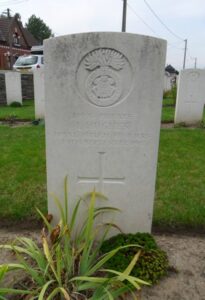
Thomas Lewis Humphries, Private, 58308, Welsh Regiment. Thomas was the son of William and Ellen Humphries, of Gwendraeth, Borough Road, Loughor, and the husband of Bronwen Humphries. He enlisted at Gorseinon into the 3rd Battalion, South Wales Borderers, and was posted to France on 6 September 1918, joining the 13th Battalion, Welsh Regiment, which was attached to 114 Brigade, 38th (Welsh) Division. The division was two weeks into its part of the great offensive, and Thomas joined his battalion in time to take part in the fighting around the Hindenburg Line. He was wounded in the thigh on 8 October and evacuated to No 11 Stationary Hospital, where he died on 11 October 1918, aged 20. He is buried in St. Sever Cemetery Extension, Rouen, France.
Ernest William Huxtable, Sergeant, 3756, 6th Dragoon Guards (Carabiniers). Ernest was born in Barnstaple in 1879, the son of George and Ann Huxtable. By 1891 the family was living at Kingsbridge Gorseinon. Ernest had worked as a tinworker and was a pre-war regular soldier who had enlisted in 1896, serving in the Boer War of 1899-1902. He had married Ellen Caroline Menpes whilst stationed in India on 18 May 1904. At the outbreak of war the 6th Dragoon Guards were still in India, stationed around Lucknow. It was recalled to England, joining the 1st Cavalry Brigade, 1st Cavalry Division and moved to France. Ernest arrived in France on 16 August 1914. He was killed in action whilst running forwards through heavy fire to light a fuse and blow a bridge between Valenciennes and Mons, during the retreat from Mons, on 23 August 1914. Due to the chaotic nature of the retreat, many of the men killed during this period do not have known graves, and neither has Ernest. He was 35 years old and is commemorated on the La Ferte-Sous-Joarre Memorial, France. Ernest is not commemorated on the Loughor War Memorial.

William John Huxtable, Private, 203323, Welsh Regiment. William was born at Loughor in 1885. He resided at 26, The Row, Tumble for most of his life, with his adoptive parents John and Margaret Charles. William enlisted at Llanelli into the 1/4th Battalion, Welsh Regiment, which was the local Territorial Battalion, attached to 159 Brigade, 53rd (Welsh) Division. William does not seem to have served overseas with the battalion, but sadly killed himself while suffering from depression at Hearston Camp, Pembrokeshire on 15 August 1917, aged 32. William is buried at Llannon (St. Non) Churchyard. He is not commemorated on the Loughor War Memorial.
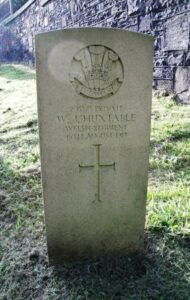
David Jenkins, Gunner, 28525, Royal Field Artillery. David was the husband of Catherine Jenkins, of Tanycoed, Upper Loughor. He worked at the Mountain Colliery at Gorseinon prior to enlisting at Gorseinon into the Royal Field Artillery, and was posted to France with the 51st Battery, 39th Brigade, Royal Field Artillery on 21 June 1915. The brigade was attached to the 1st Division, and took part in the Battle of Loos from 25 September 1915. It remained in the Loos sector over the coming months. David was killed in action just a month before the division moved to the Somme, when a barrage of 8” German shells struck his billet on 26 June 1916, bringing the roof down. He was 40 years old, and is commemorated on the Loos Memorial, France. David is not commemorated on the Loughor War Memorial.

Edward Daniel John, Private, 48082, Welsh Regiment. Edward was the son of William and Mary John, of Pen y Bank, Upper Loughor. He was a furnaceman at the Grovesend Tinplate Works prior to enlisting at Swansea into the Welsh Regiment, and was posted to Salonika in 1916, joining the 1st Battalion, Welsh Regiment, which was attached to 84 Brigade, 28th Division. Edward was killed in action in Salonika on 31 May 1917, aged 23. He has no known grave and is commemorated on the Doiran Memorial, Greece.
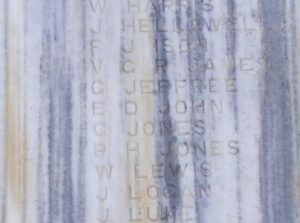
Frederick John, Private, 43608, Welsh Regiment. Frederick was born at Bancyfelin, the son of William and Adalide John. William had been the Station Master there before moving the family to Sarnau, 3, Whitley Road, Loughor. Frederick enlisted at Llanelli into the Welsh Regiment, and at some time in 1916 was posted to France, joining the 16th Battalion, Welsh Regiment, which was attached to 115 Brigade, 38th (Welsh) Division. The Division had been in France since December 1915 and had spent their first winter in the trenches near Armentieres. In June they marched south to the Somme, where they were tasked with the capture of Mametz Wood. The attack began on 7 July, but met with fierce resistance, and it took until 12 July to clear the wood. The Division suffered terrible casualties at Mametz, and were taken out of the line, and moved to Ypres to rebuild. Here they fought at Pilckem and Langemarck, which is where Frederick was killed on 27 August 1917, aged 24. He is remembered on the Tyne Cot Memorial, Belgium. He is also remembered on the headstone of his parent’s grave at Box Cemetery, Llanelli. Frederick is not commemorated on the Loughor War Memorial.
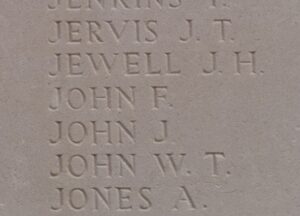
Mansel John, Private, 57042, Welsh Regiment. Mansel was the son of David and Sarah John, of Tymawr, Loughor. He married Emily Thomas in 1906, and the couple set up home at Sea View, Loughor. Mansel enlisted at Bridgend into the Glamorgan Yeomanry, and was posted to France in 1917, joining one of the Welsh Regiment battalions attached to the 38th (Welsh) Division. Mansel was wounded while the division was at Ypres, and was invalided home. He attended a reception concert in Loughor in August 1917 just prior to being sent back to France, joining the 18th Battalion, Welsh Regiment, which was attached to 119 Brigade, 40th (Bantam) Division. In March 1917 the Germans withdrew to their shortened line, called the Hindenburg Line, and the 40th Division was one of the Divisions that followed the withdrawal. Later in the year it took part in the Battle of Cambrai, playing an important role in the attack on Bourlon Wood. Mansel was killed at Bourlon Wood on 23 November 1917, aged 31. He has no known grave, and is commemorated on the Cambrai Memorial, Louverval, France. Mansel is not commemorated on the Loughor War Memorial.
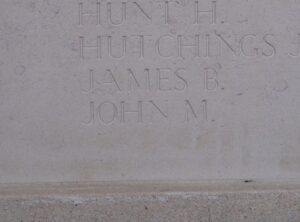
Emrys Jones, Sergeant, 1829, Devonshire Regiment. Emrys was born on 10 September 1892, the son of Thomas and Mary Jones, of Lewis Terrace, Loughor. He was educated at Gorseinon and at the University of Exeter before taking up a post at Assistant Master at St. Sidwell’s School, Exeter. He enlisted into the 4th Battalion, Devonshire Regiment in August 1914 and embarked for India with the battalion on 4 October 1914. From India the battalion was despatched in May 1915 to Mesopotamia attached to the 37th Indian Brigade, 14th Indian Division. Emrys was killed in action in Mesopotamia (modern Iraq) on 22 November 1915, aged 23. He has no known grave and is commemorated on the Basra Memorial, Iraq. His brother, Gomer, also fell. Neither brother is commemorated on the Loughor War Memorial.
Gomer Jones, Private, STK/722, Royal Fusiliers. Gomer was the son of Thomas and Mary Jones, of Lewis Terrace, Loughor. He enlisted in London into the 10th (Stockbrokers) Battalion, Royal Fusiliers. The battalion landed in France on 30 July 1915, attached to 111 Brigade, 37th Division. The division landed at Boulogne on 30 July 1915 and concentrated near St Omer. It then took part in the attack on the Gommecourt Salient on 1 July 1916, during the first phase of the Battle of the Somme. From 6 July two of the Division’s infantry Brigades (111 and 112) and the Divisional pioneers were then attached to the 34th Division, which had suffered very heavy losses in the attack on La Boiselle. Gomer was killed in action during this detachment, on 15 July 1916, aged 22. He has no known grave and is commemorated on the Thiepval Memorial, France. His brother, Emrys, also fell. Neither brother is commemorated on the Loughor War Memorial.
James Thomas Jones, Private, 21511, Welsh Regiment. James was the son of James and Catherine Jones, of Bryncelyn, Belgrave Road, Loughor. He had married Elizabeth James in 1908, and the couple lived at Roseland Road, Waunarlwydd with their three daughters. James enlisted at Swansea on 11 November 1914 into the Welsh Regiment, and was posted to France on 5 March 1915, joining the 2nd Battalion, Welsh Regiment, which was attached to 3 Brigade, 1st Division. James was killed in action at Festubert, during the Second Battle of Ypres on 25 May 1915, aged 27. He has no known grave and is commemorated on the Le Touret Memorial, Richebourg-L’avoue, France. James is not commemorated on the Loughor War Memorial.
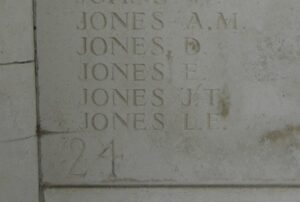
John Haydn Jones, Driver, 25807, Royal Engineers. John was born at Llandeilo Talybont, the son of James and Catherine Jones. His parents later resided at Brynarllwyn, Belgrave Road, Loughor. John enlisted at Llanelli into the Royal Engineers, and was posted to France on 7 October 1914 to join the 8th Signal Troop as a despatch rider. He was killed in Flanders on 29 April 1915, aged 19. John is buried at Hazebrouck Communal Cemetery, France. He is not commemorated on the Loughor War Memorial.
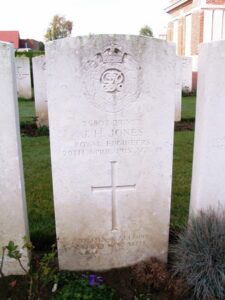
Joseph Jones, Private, 265995, Welsh Regiment. Joseph lived in Loughor, and enlisted at Gorseinon into the 1/6th Battalion, Welsh Regiment. The battalion formed in the town in August 1914, and on 29 October 1914 landed at Le Havre and moved to work on Lines of Communication. On 5 July 1915 it came under orders of 84 Brigade, 28th Division, then on 23 October 1915 transferred to 3 Brigade, 1st Division, before finally becoming the Pioneer Battalion to the 1st Division on 15 May 1916. The division fought on the Somme that year, and followed the German retreat to the Hindenburg Line in early 1917 before moving to the Flanders Coast during the summer of 1917. While training on the coast, the Battle of Third Ypres had stalled in the mire, and the Division was recalled to Ypres, fighting at the Second Battle of Passchendaele. The division wintered in Flanders. Joseph was killed in action near Ypres on 28 February 1918. He is buried in Duhallow A.D.S. Cemetery, Belgium.
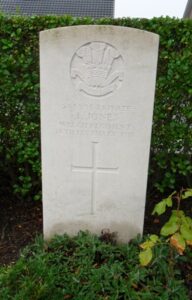
Arthur Sydney Kidston, Private, PO/12784, Royal Marine Light Infantry. Arthur was born at Teignmouth, Devon on 2 October 1884, the son of Samuel and Susan Kidston. The family later moved to Maes-yr-Laf, Yspitty, Loughor. Arthur enlisted into the Royal Navy, and was posted aboard the armoured cruiser HMS Black Prince. She was transferred from the Mediterranean to the Grand Fleet in December 1914. Black Prince was sunk after becoming separated from the rest of the fleet during the night action of the Battle of Jutland on 31 May 1916, with the loss of all of her crew of 857 men. Arthur was 31 years old when he died that day, and is commemorated on the Portsmouth Naval Memorial, Hampshire. Arthur is not commemorated on the Loughor War Memorial.
James Law, Private, Welsh Regiment. James was the son of David and Mary Law, of Castle Street, Loughor. Not much is presently known about him, but he had served with the 4th Welsh at some time during the war. He died on 20 August 1918, aged 20, and is buried with his parents and sister at Box Cemetery, Llanelli. He is not commemorated by the Commonwealth War Graves Commission. James is not commemorated on the Loughor War Memorial.
David John Lewis, Sergeant, 17318, Royal Welsh Fusiliers. David was the only son of Esther Lewis, of Pont-y-Brenin, Kingsbridge, Gorseinon. He married Beatrice Powell, of Fforestfach, in about 1909 and the couple lived at Loughor with their two sons. David worked at Garngoch No 3 Colliery prior to enlisting into the Royal Welsh Fusiliers at the outbreak of war and was posted to France on 18 May 1915, joining the 1st Battalion, Royal Welsh Fusiliers, which was attached to 22 Brigade, 7th Division and was in the midst of the Battles of Aubers Ridge and Festubert. He fought with the battalion during the Battle of Loos later that year, and saw much fighting. In the summer of 1916, the Division was on the Somme, and took part in the Battle of Albert, where it captured Mametz village. It then fought at the Battle of Bazentin before moving into reserve, spending the first three weeks of August rebuilding and training in the Dernancourt area. On 26 August the battalion moved forwards in preparation for an assault on the village of Ginchy. Orders for the attack were issued during the night of 26-27 August and the following day was spent getting into position and preparing for the attack. During the afternoon a party of Germans was found to have occupied a new trench in front of the battalion, so a party of men were sent forward to clear them out. Fifteen men were killed and 56 wounded during the operation. Further fighting continued on the following day, and David was most likely killed during an attempt to join up with the Durham Light Infantry in Ale Trench on 28 August 1916. He was 28 years old and is commemorated on the Thiepval Memorial, France.

Frederick Lewis, Private, 13902, Devonshire Regiment. Frederick was the adopted son of Samuel and Martha Grinter, of Arsofa House, Bryn Road, Loughor. He enlisted at Gorseinon into the army, and was posted to France on 22 September 1915 with the 10th Battalion, Devonshire Regiment, which was attached to 79 Brigade, 26th Division. During November the division was transferred to Salonika, where it remained for the duration of the war. Frederick was badly wounded in Salonika, and died on 26 July 1918, aged 30. He is buried in Karasouli Military Cemetery, Greece. Frederick is not commemorated on the Loughor War Memorial.
Harry Lewis, Private, 238093, Worcestershire Regiment. Harry was the son of William and Anne Lewis, of Gower Terrace, Loughor. He had enlisted into the 1/6th Battalion, Welsh Regiment at Swansea, and landed in France with the battalion on 29 October 1914. At some time afterwards he was wounded, and had a spell with the Labour Corps before being transferred to the 17th Battalion, Worcestershire Regiment, which had been formed in France as a result of the German offensives of March and April 1918. The battalion became the Pioneer Battalion of the 40th Division, and took part in the great advance from August 1918 onwards. Harry survived the war, but died of pneumonia just after the Armistice, on 14 November 1918, aged 30. He is buried in St. Andre Communal Cemetery, France. Harry is not commemorated on the Loughor War Memorial.
Trevor Lloyd, Rifleman, C/909, King’s Royal Rifle Corps. Trevor was born in Loughor, the son of John and Louise Lloyd. The family later resided at Elba Street, Gowerton. Trevor enlisted at Swansea into the 16th Battalion, King’s Royal Rifle Corps, which was attached to 100 Brigade, 33rd Division, and landed in France on 16 November 1915. He was in France for only a month when he was killed in action near Loos on 16 December 1915, aged 20. Trevor is buried in Guards Cemetery, Windy Corner, Cuinchy, France. He is not commemorated on the Loughor War Memorial.
John Ceiriog Hughes Morgan, Private, 27484, Kings Shropshire Light Infantry. John was the son of William and Janet Morgan, of Castle House, Loughor. He had originally served with the Welsh Regiment, before being transferred to the 1st Battalion, King’s Shropshire Light Infantry. The battalion served on the Western front for the duration of the war, attached to 16 Brigade, 6th Division. John survived the war, but died at Llanelli on 17 July 1921, aged 28. He is buried in Loughor (St. Michael) Churchyard. John is not commemorated on the Loughor War Memorial.
Joseph Emlyn Morgan, Second Engineer, Mercantile Marine. Joseph was born at Trefilan in 1883, the son of John and Mary Morgan. In 1906 he married Rachel Anne Richards, and settled at 8, Penlan Road, Loughor. Joseph served with the Mercantile Marine aboard the S.S. Bamse, a London registered cargo steamer. On 18 April 1918, Bamse was en route from Rouen to Swansea when she was torpedoed and sunk by the German submarine UB-80, with the loss of four lives. Joseph was 34 years old when he died that day, and is commemorated on the Tower Hill Memorial, London.
John Morgans, Private, 42304, Manchester Regiment. John was the cousin of Mary Evans, of Voga House, Glebe Road, Loughor. He enlisted into the Royal Field Artillery at Llanelli but was later posted to the 16th Battalion, Manchester Regiment, which was attached to 90 Brigade, 30th Division. The division saw its first major action during the Somme Offensive, at the Battle of Albert, where it captured Montauban, and fought during the latter stages of the offensive, during the Battle of Le Transloy, before wintering on the Somme. In March 1917 the Division followed the German Retreat to the Hindenburg Line, and in April took part in the First and Second Battles of the Scarpe. Later that year it moved north to Ypres, and fought at the Battle of Pilckem Ridge. John was killed in action during the opening assault, on 31 July 1917. He has no known grave and is commemorated on the Ypres (Menin Gate) Memorial, Belgium. John is not commemorated on the Loughor War Memorial.
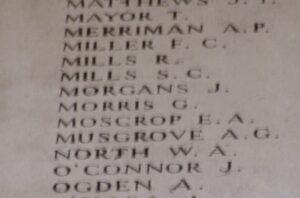
Ernest George Murphy, Private, 43220, Welsh Regiment. Ernest was the son of Henry and Mary Anne Murphy, of Oymi House, Waun Road, Loughor. He enlisted at Loughor into the army, and was posted to the 15th Battalion, Welsh Regiment, which was known as the Carmarthen Pals battalion, attached to 114 Brigade, 38th (Welsh) Division. On 2 December 1915 the battalion moved to France, and the entire Division moved to the Fleurbaix sector, where it was initiated into trench warfare. During June 1916 the Division marched south to the Somme, and on 7 July 1916 attacked Mametz Wood. The initial attack failed, and it was three days later, on 10 July, that a fresh attack was mounted. After two days of heavy hand to hand fighting within the wood, the Germans withdrew, and the battered Welshmen moved via Hébuterne to the 2nd Army School of Instruction on 3 August. Ernest was oddly killed while the battalion was still attached to the School, on 16 August 1916, aged 22. He has no known grave and is commemorated on the Ypres (Menin Gate) Memorial, Belgium. I would speculate that his official date of death is incorrect, and that he may have actually been killed on 16 August 1917 at Langemarck.
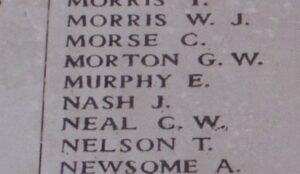
William Pitts, Private, 30774, Welsh Regiment. William was born at Whitechapel. He had worked as a Waggoner at Llanfihangel Aberbythych prior to moving to Loughor. He enlisted at Maesteg into the army, and was posted to the 14th Battalion, Welsh Regiment, which was attached to 114 Brigade, 38th (Welsh) Division. He probably joined the battalion in France after the 38th Division had withdrawn from the Somme, following its assault on Mametz Wood, and would have joined the battalion at Ypres. He was killed in action while the 14th Welsh was in positions in the front line facing the Boesinghe Canal on 20 January 1917, aged 23. He is buried in Bard Cottage Cemetery, Belgium.
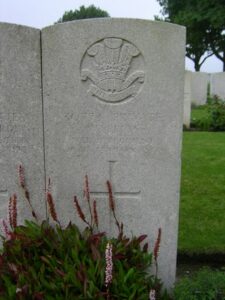
David Edgar Powell, Private, 16676, Royal Welsh Fusiliers. David was the son of David and Mary Ann Powell, of Greenfield Place, Loughor. He played rugby for Loughor RFC prior to the war and enlisted at Gorseinon into the 9th Battalion, Royal Welsh Fusiliers, which was attached to 58 Brigade, 19th (Western) Division. The battalion moved to France on 18 July 1915, and moved with the division to positions near Loos, where it took part in the opening attack of the Battle of Loos on 25 September 1915. David survived the divisions terrible ordeal when it went over the top at Givenchy that day, but was later unfortunately killed during an accident which occurred while at bomb throwing practise on 23 November 1915, aged 19. He is buried in Vieille-Chapelle New Military Cemetery, Lacouture, France. David is not commemorated on the Loughor War Memorial.

Alfred James Powley, MC, Captain, New Zealand Rifle Brigade. Alfred was born in Wellington, New Zealand on 6 March 1886, the son of Alfred Josiah Powley and Margaret Winifred Powley (nee Evans), an emigrant from Loughor. He was a solicitor in New Zealand, and married Jane Morgan, of St. Helier’s Bay, Auckland, while home on leave on 30 September 1915. He was commissioned into the New Zealand Infantry, and had taken part in the campaign in Samoa before being embarking for Egypt on 9 October 1915. He served in Egypt before embarking for France, joining B Company, 4th Battalion, 3rd New Zealand Rifle Brigade. Alfred wrote to his Aunt, Mrs Dennis, at Dan-y-Bryn, Loughor at the time of his move to France, expressing his hopes to visit his family there soon. The New Zealanders moved to the Somme however, and were to take part in heavy fighting around Longueval. Alfred was badly wounded here, and died on 20 September 1916, aged 30. He is buried in Heilly Station Cemetery, Mericourt-L’abbe, France. He was awarded the Military Cross for his gallantry in the fighting which led to his death. The citation was published in the London Gazette of 22 September 1916, and read: ‘For conspicuous gallantry during a raid on the enemy’s trenches. His party was heavily encumbered by eight wounded, one dead man, and nine prisoners, but with great determination he got them all in safely.’ Alfred is not commemorated on the Loughor War Memorial.
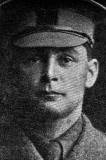
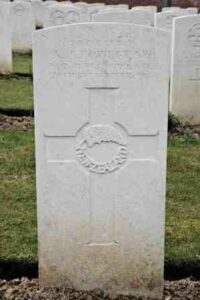
William John Protheroe, Private, 265853, Welsh Regiment. William was born in Loughor, the son of John and Margret Protheroe. The family later resided in Gorseinon. He enlisted at Gorseinon into the 1/6th Battalion, Welsh Regiment. The battalion was one of the first territorial units to move to France in August 1914. Initially, in late 1914 and early 1915, they were on lines of communication and in July 1915 were based in the Locre and Kemmel area, facing the Germans who were on the high ground at Spanbroekmolen. The battalion was in the trenches, but also doing work repairing trenches etc. On 5 July 1915 the battalion was attached to 84 Brigade, 28th Division, and took part in the Battle of Loos. On 23 October 1915 the battalion was transferred to 3 Brigade, 1st Division, becoming the Divisional Pioneer Battalion on 15 May 1916, before moving to the Somme. The division fought throughout the Somme offensive, and the following year fought at the Third Battle of Ypres. It saw heavy fighting during the German offensive of March 1918, and later that year took part in the great advance. William was badly wounded during the Battle of the Aisne, and died on 11 May 1918, aged 34. He is buried in Étaples Military Cemetery, France. William is not commemorated on the Loughor War Memorial.
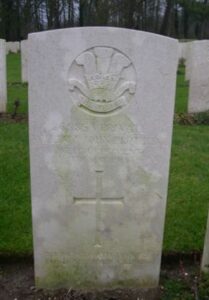
Frederick Purchase, Private, 13039, Oxford & Bucks Light Infantry. Frederick was born at Weymouth, Dorset in 1886, and was the Husband of Hannah Purchase, of 3, Grove Terrace, Glanyravon Road, Pontardulais. He enlisted at Swansea into the army, and was posted to the 7th Battalion, Oxford & Bucks Light Infantry, which was attached to 78 Brigade, 26th Division. On 21 September 1915 the battalion landed at Boulogne, but moved to Salonika in November 1915. Frederick was killed in Salonika on 17 August 1918. He was 33 years old, and is buried at Karasouli Military Cemetery, Greece. Frederick is not commemorated on the Loughor War Memorial.

John Emlyn Rees, Lance Serjeant, 2450, Welsh Regiment. John was the of Daniel and Naomi Rees, of Ael-Y-Bryn, Belgrave Road, Loughor. He had been the Secretary of Loughor Rugby Club prior to the war, and enlisted at Gorseinon into the 1/6th Battalion, Welsh Regiment. The battalion was one of the first territorial units to move to France in August 1914. Initially, in late 1914 and early 1915, they were on lines of communication and in July 1915 were based in the Locre and Kemmel area, facing the Germans who were on the high ground at Spanbroekmolen. The battalion was in the trenches, but also doing work repairing trenches etc. On 5 July 1915 the battalion was attached to 84 Brigade, 28th Division, and took part in the Battle of Loos. On 23 October 1915 the battalion was transferred to 3 Brigade, 1st Division, which was in the Loos sector. John died at Loos on 21 February 1916, aged 24. He is buried in Maroc British Cemetery, Grenay, France.
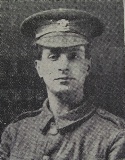
Lewis Thomas Rees, Private, 19976, Royal Welsh Fusiliers. Lewis was the son of John and Hannah Rees, of Manse Place, Upper Town, Loughor. He worked at the Mardy Tinplate Works at Gorseinon prior to enlisting at Swansea into the army, and was posted to the 9th Battalion, Royal Welsh Fusiliers, which was attached to 58 Brigade, 19th (Western) Division. The battalion moved to France on 18 July 1915, and moved with the division to positions near Loos, where it took part in the opening attack of the Battle of Loos on 25 September 1915. The following year the Division moved to the Somme, where it took part in the second wave of the attack on Ovillers-La Boisselle on 1 July, capturing the village at heavy cost. Lewis was badly wounded during the fighting here, and died on 7 July 1916, aged 20. He is buried in Heilly Station Cemetery, Mericourt-L’Abbe, France.
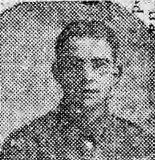
David Richards, Private, 5948, Welsh Regiment. David was the husband of Kate Richards, of Rose Cottage, Woodland Road, Upper Town, Loughor. He had enlisted at Swansea into the 1st Battalion, Welsh Regiment, which was stationed in Chakrata, India, part of Dehra Dun Brigade, Meerut Division at the outbreak of war. The battalion returned to England, landing at Plymouth on 22 December 1914, and landed in France with 84 Brigade, 28th Division on 18 January 1915. The division had its baptism of fire during the Second Battle of Ypres, and it was there that David was killed on 3 February 1915, aged 39. He has no known grave and is commemorated on the Ypres (Menin Gate) Memorial, Belgium. He was Loughor’s first casualty of the war on the Western Front.
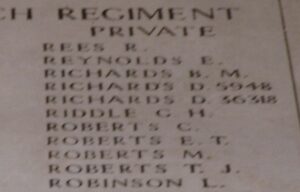
Thomas Edward Rogers, Private, 15179, Royal Welsh Fusiliers. Thomas was the son of Samuel and Margaret Rogers, of 12, Alun Terrace, Mold. He lived at Pendry Road, Loughor prior to the war, and worked at the Grovesend Tinplate Works. He enlisted at Wrexham along with Ernest Strode into the 10th Battalion, Royal Welsh Fusiliers, which was attached to 76 Brigade. The battalion landed in France on 27 September 1915, and moved with 76 Brigade to join the 3rd Division. The battalion saw its first actions at Ypres, near an area known as The Bluff. Thomas was wounded here, and died at Remi Sidings Casualty Clearing Station on 17 February 1916, aged 26. He is buried in Lijssenthoek Military Cemetery, Belgium.

Walter Ryall, Lance Corporal, 12571, West Riding Regiment. Walter was the son of William and Maria Ryall, of Templecombe, Somerset. He had enlisted into the army as a teenager, and after having served until around 1908 left the army to work as an annealer at Gorseinon, becoming an army reservist. He married Lottie May Barrett, of Bryn Road, Loughor in 1909 before becoming a postman. Walter was recalled to the colours, and on 29 April 1915 posted to the 2nd Battalion, Duke of Wellington’s (West Riding) Regiment, which was attached to 13 Brigade, 5th Division. He was killed during a German gas attack on 5 May 1915, just a week after arriving on the Western Front. Walter was 32 years old and is commemorated on the Ypres (Menin Gate) Memorial, Belgium. He is not commemorated on the Loughor War Memorial.
William Smith, Private, 12876, Welsh Regiment. William was from Shrewsbury, but lived with his wife Sarah Ann Smith at Loughor prior to the war. He enlisted at Gorseinon into the 8th Battalion, Welsh Regiment, which was attached to 40 Brigade, 13th (Western) Division. On 13 June 1915 the Division sailed for Alexandria, and moved to Mudros before being landed at Cape Helles, Gallipoli from 6 July 1915, relieving the 29th Division. The division returned to Mudros at the end of the month, before being landed at ANZAC Cove from 3 August 1915. William was killed in action here during the Battle of Sari Bair, on 8 August 1915. He has no known grave and is commemorated on the Helles Memorial, Gallipoli. His widow Sarah later married David John of Royal Oak Cottage, Loughor Road, Kingsbridge, Gorseinon, and lived until 1973. William is not commemorated on the Loughor War Memorial.
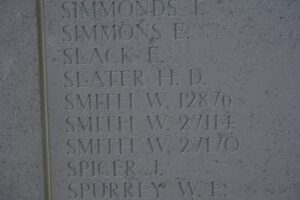
Thomas Solman, Corporal, 760, Middlesex Regiment. Thomas was born in Honiton, Devon in 1880, the son of Walter and Susan Solman. He was living in Cardiff by 1901, where he worked as a railway navvy. He married Harriet Caswell at St. Saviours, Cardiff on 13 April 1903, and the couple moved to Loughor by 1907 after Thomas had gained work at the ship-breaking works, at King’s Dock. Thomas enlisted at Swansea on 20 March 1915 into the 18th Battalion, Middlesex Regiment, which was a pioneer battalion attached to the 33rd Division. The Division moved to France during November 1915, and saw its first major action during the Battles of the Somme, from July 1916 onwards. On 17 August 1916 Thomas was part of a working party repairing a trench near Mametz Wood, when a German shell burst overhead, killing Thomas and two of his comrades. The three men were buried by their comrades in what is Flatiron Copse Cemetery, Mametz, France. Thomas was 34 years of age.

Ernest Strode, Private, 15178, Royal Welsh Fusiliers. Ernest was the son of Tom and Jennie Strode, of Panteg House, Castle Street, Loughor. He enlisted at Wrexham along with Thomas Rogers into the 10th Battalion, Royal Welsh Fusiliers, which was attached to 76 Brigade. The battalion landed in France on 27 September 1915, and moved with 76 Brigade to join the 3rd Division. The battalion saw its first actions at Ypres, near an area known as The Bluff. During the summer the division moved south to the Somme, and fought in the Battle of Bazentin, capturing Longueval. It then took part in the Battle of Delville Wood, which saw the 10th RWF win two VC’s, and in the Battle of the Ancre, before settling into another bleak winter in France. In May 1917 the Division was at Arras, and fought at the First and Second Battles of the Scarpe, and at the Battle of Arleux. Ernest was badly wounded here, and died on 28 April 1917, aged 22. He is buried in Faubourg D’amiens Cemetery, Arras, France.
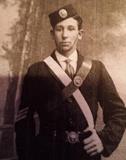
Howell Thomas, Private, 14035, Northumberland Fusiliers. Howell was the son of William and Elizabeth Thomas, of 10, Greenfield Place, Upper Loughor. He enlisted at Gorseinon into the 8th Battalion, Northumberland Fusiliers, which was attached to 34 Brigade, 11th (Northern) Division. The division sailed for Gallipoli in July 1915, and was evacuated to Egypt in January 1916, before embarking for France in July 1916. It took part in the Somme offensive that summer, and wintered on the Ancre. Howell was wounded early in 1917, and died of his wounds on 10 February 1917, aged 25. He is buried in Mont Huon Military Cemetery, Le Treport, France. Howell is not commemorated on the Loughor War Memorial.
James Thomas. This man cannot presently be identified.
Joseph Arthur Vaughan, Private, 1636, Welsh Regiment. Joseph was born at Pontarddulais in 1884 and married Sarah Ann Harris at Llanelli in 1907. The couple resided in Loughor with Sarah’s parents. He enlisted at Gorseinon into the 1/6th Battalion, Welsh Regiment. On 29 October 1914 the battalion landed at Le Havre and moved to work on Lines of Communication. On 5 July 1915 it was attached to 84 Brigade, 28th Division, then on 23 October 1915 transferred to 3 Brigade, 1st Division. Joseph was killed at Loos on 12 December 1915. He was 31 years old, and is buried in Philosophe British Cemetery, Mazingarbe, France.

Brynmor Williams, Private, 30233, South Wales Borderers. Brynmor was born at Loughor in 1898, the son of William and Rachel Williams. The family had moved to Sunny Bank, Garngoch, Gorseinon prior to the war, and Brynmor enlisted at Cardiff into the army. He was posted to the 2nd Battalion, South Wales Borderers, which was in France attached to 87 Brigade, 29th Division. The division had been on the Western Front since seeing much action at Gallipoli, and had been decimated during the assault at Beaumont Hamel during the opening day of the Battle of the Somme. After rebuilding it took part in later fighting around Le Transloy that summer, and in the Spring of 1917 fought at the Battle of the Scarpe. It was then moved further north to Ypres, and fought at the Battle of Langemarck, and then at the Battles of the Menin Road, Polygon Wood, Broodseinde and Poelcappelle, before moving to Cambrai. Here the division saw more heavy fighting at the Battle of Cambrai in November and December 1917 before moving back to Flanders early in 1918. The German Spring Offensive hit the British on the Somme on 21 March 1918, and hit in Flanders just weeks later. The 29th Division fought at the desperate defensive battles of Estaires, suffering terrible casualties again. Brynmor was killed in action here on 11 April 1918, aged 19. He is buried in Trois Arbres Cemetery, Steenwerck, France.
John Benjamin Williams, Leading Seaman, Wales Z/3030, Royal Naval Volunteer Reserve. John was born on 13 March 1896, the son of David Robert Williams, of Cryd-yr-Awel, Belgrave Road, Loughor. He enlisted into the Royal Naval Volunteer Reserve, and was posted aboard cargo steamer SS St Olaf. On 15 December 1917, St. Olaf left Cardiff for Honfleur, and was never seen again, presumably lost due to enemy action. John was 21 years old when he disappeared along with his ship, and is commemorated on the Plymouth Naval Memorial, Devon. John is not commemorated on the Loughor War Memorial.
Uriel Vincent Williams, Guardsman, 3055, Welsh Guards. Uriel was the son of William and Ann Williams, of Swansea. He worked as a Behinder in the St. David’s Tinworks and lived at Ivy Cottage, Frampton Road, Loughor with his brothers and sisters prior to the war. He enlisted at Gowerton into the 1st Battalion, Welsh Guards. Uriel probably joined the battalion after its exploits on the Somme, where it was attached to the 3rd Guards Brigade, Guards Division. The remained on the Somme for the winter, and in March 1917 took part in the advance caused by the German Retreat to the Hindenburg Line. Later that year it moved north to Ypres, and fought at the Battle of the Pilkem Ridge. The Guards then fought at the Battles of the Menin Road, Poelcapelle and the First Battle of Passchendaele. Uriel was killed in action on Passchendaele Ridge on 12 October 1917, aged 28. He has no known grave and is commemorated on the Tyne Cot Memorial, Belgium. Uriel is not commemorated on the Loughor War Memorial.
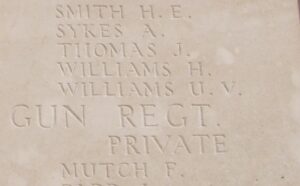
George Hacking Wood, Sapper, 62757, Royal Engineers. George was the son of George and Susannah Wood, of Darwen, Lancashire. He married Edith Mabel Beatrup in 1909, and the couple moved to Dock Street, Loughor. He was a mason by trade, and enlisted into the 124th Field Company, Royal Engineers at Porthcawl on 29 December 1914. The company was attached to the 38th (Welsh) Division, and during the summer of 1915 moved into camp at Winchester, where it trained prior to its move to France in December 1915. George was injured during training on 6 September 1915, and his injury required extensive surgery to his groin and removal of his testicles. He was discharged from the army as medically unfit on 12 May 1916, and died on 21 June 1919, aged 37. He is buried in Kingsbridge Cemetery, Swansea. George is not commemorated on the Loughor War Memorial.
Hugh Cadifor Wood, Private, 50251, North Staffordshire Regiment. Hugh was the son of John and Jane Wood, of Hafren Street, Llanidloes. He worked as a builder at Loughor prior to the war and lodged at 12, Duffryn Place, Gorseinon. He married Maggie Owen, of Trefeglwys, Montgomeryshire in 1913 before moving there and the couple had two sons during the coming years. Hugh enlisted into the Royal Engineers on 15 December 1915 and was mobilised in February 1917. Upon landing in France he was transferred to the 9th Battalion, North Staffordshire Regiment, which was a Pioneer unit attached to the 37th Division. Hugh was wounded during the time of the German offensives and evacuated to No 9 General Hospital, where he died of wounds on 21 May 1918 aged 28. He is buried in St. Sever Cemetery Extension, Rouen, France. Hugh is not commemorated on the Loughor War Memorial.
World War Two, 1939-1945
James MacDonald Adams, BA, Sub-Lieutenant (A), Royal Naval Volunteer Reserve. James was the son of Arthur Willie and Olwen May Adams, of Loughor. He joined the Royal Naval Volunteer Reserve, and was posted to H.M.S. Shrike, a Fleet Air Arm base in Northern Ireland, which was used by 836 Squadron. Little else is presently known of James, but he died in an aircraft accident while flying off the MV Empire McAndrew, a converted merchant ship, on 28 July 1944, aged 27. He is commemorated on the Lee-On-Solent Memorial, Hampshire. James is not commemorated on the Loughor War Memorial.
Graham Aeron Alcock, Sergeant, 978333, Royal Air Force Volunteer Reserve. Graham was the son of William and Margaret Alcock, of Garden Village, Gorseinon. He enlisted into the Royal Air Force Volunteer Reserve and trained as a Wireless Operator/ Air Gunner before being posted to 10 Squadron, Royal Air Force, which was based at RAF Leeming, equipped with the Armstrong Whitworth Whitley. Graham died on 1 July 1941 aged 20 and his death was registered in Norfolk, so it is likely that he was involved in an aircraft crash. He is buried in Kingsbridge Cemetery, Glamorgan.
William Albert Berry, Able Seaman, D/JX 198536, Royal Navy. William was born on 13 August 1917, the son of William James Berry and Winifred Berry, of Gorseinon. He married Kitty Skelton, of Whitehaven, Cumberland in 1942. William enlisted into the Royal Navy and served aboard the Black Swan class sloop, HMS Kite. The ship had a short, but successful, career following her commissioning on 1 March 1943. Alongside other ships, she took part in the sinking of at least five U-Boats prior to her last voyage. On 20 August 1944 Kite was escorting the aircraft carriers Vindex and Striker, as part of the escort fleet of convoy JW-59 to Northern Russia, when the convoy was sighted in the Barents Sea by German aircraft. Within hours the convoy came under attack by a pack of U-Boats. One U-boat was sunk by Fairey Swordfish aircraft from one of the carriers, while two more were sunk by destroyers. Early the following day, Kite was struck by two torpedoes, forcing her crew to abandon ship in the icy Arctic seas. Of her crew of 10 officers and 207 ratings, 60 survived the attack, but due to the freezing cold, only nine survived to reach shore. U-344 was sunk the next day. William was 26 years old when he died on 21 August 1944 and is commemorated on the Plymouth Naval Memorial, Devon.
William Benjamin Bowen, Leading Aircraftman, 1029215, Royal Air Force Volunteer Reserve. William was the son of Thomas David and Margaret Bowen, of Llanelli. He married Irene Morgan, of Loughor, early in 1942. He served with 276 Squadron, RAF, which was an air sea rescue unit, based at RAF Perranporth, and equipped with the Boulton Paul Defiant I. William died in Devon on 5 July 1942, aged 22. He was brought home and buried in Llanelli (St. Paul) Churchyard. William is not commemorated on the Loughor War Memorial.
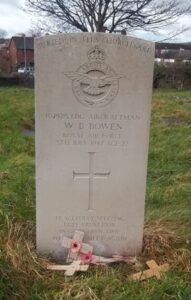
Harold Breeze, Private, 14652183, Devonshire Regiment. Harold was the son of John and Margaret Breeze, of Loughor. He served with the 2nd Battalion, Devonshire Regiment, which was attached to 231st Infantry Brigade. The brigade had fought at Malta, Sicily, and Italy, before returning to Britain to prepare for the D-Day landings. It landed in Normandy on D-Day, 6 June 1944, and took part in the fighting to consolidate the beach-head, before taking part in the break-out from the beaches. Harold was killed in Normandy during Operation Bluecoat, on 30 July 1944, aged 20. He is buried in Tilly-Sur-Seulles War Cemetery, France.
Benjamin Cutajar, Donkeyman, Merchant Navy. Benjamin was born on 14 April 1895, the son of Phillip and Carrie Cutajar, and the husband of Ann Cutajar, of Loughor. He served with the Merchant Navy aboard the Middlesbrough registered tanker S.S. Empire Amethyst. On 20 February 1942 Empire Amethyst left Swansea for New Orleans, where she filled up with petroleum spirit. She left New Orleans on 6 April 1942, bound for Freetown. Early in the morning of 14 April 1942 she was struck by a torpedo which had been fired by the German submarine U-154, and exploded with the loss of all 47 of her crew. Benjamin was 47 years old when he died that day, and is commemorated on the Tower Hill Memorial, London. He is not commemorated on the Loughor War Memorial.
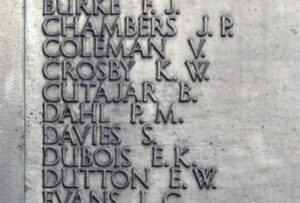
David John Edwards, Guardsman, 2737056, Welsh Guards. David was the son of Arthur Haydn Edwards and Elizabeth Jane Edwards (nee Davies), of Loughor. He served with the 2nd Battalion, Welsh Guards. The 2nd Battalion was formed in 1939 and fought during the German siege of Boulogne in 1940, before the survivors were evacuated to England. The battalion then moved to Codford for training into an armoured unit, which would see the battalion fight in Normandy as part of the Royal Armoured Corps. David appears to have been killed in an air raid on 29 June 1942, aged 27. He is buried in Watford Cemetery, Hertfordshire. David is not commemorated on the Loughor War Memorial.
Harold Hugh. This man cannot presently be identified.
Gwyn Humphrey Hughes, Private, 6085206, The Queen’s Royal Regiment (West Surrey). Gwyn was the son of Thomas David and Rebecca Hughes, of Loughor. He served with the 2nd Battalion, West Surrey Regiment. The battalion was in Palestine at the outbreak of war, and was readying for a move to Egypt when Gwyn died on 24 December 1939, aged 26. He is buried in Ramleh War Cemetery, Israel. Gwyn is not commemorated on the Loughor War Memorial.
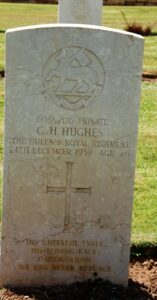
Owen Hughes. This man cannot presently be identified.
Elvet James, Private, 6102775, The Queen’s Royal Regiment (West Surrey). Elvet was the son of William and Mary James. He married Edith Mary Cavell Williams, of Loughor early in 1942, just prior to embarking for Egypt with the 1/5th Battalion, West Surrey Regiment. The battalion was attached to the 169 Brigade, 56th London Division, and Elvet joined the battalion in time to take part in the Battle of El Alamein. Elvet was killed in action here on 14 November 1942, aged 30. He has no known grave, and is commemorated on the Alamein Memorial, Egypt. Elvet is not commemorated on the Loughor War Memorial.
David Rees Douglas Jenkins, Private, 14201507, Gordon Highlanders. David was the son of Thomas and Sarah Ann Jenkins, of Pantyffynnon, and served with the 1st Battalion, (The London Scottish), Gordon Highlanders. The Battalion were in France at the outbreak of war, and held St. Valery-en-Caux in an effort to buy time for the remainder of the BEF to be evacuated from Dunkirk. The entire Battalion was captured after the surrender of France, and a new 1st Battalion was raised in Scotland, and sent to the Middle East, landing at Tripoli. David was either wounded or taken ill in North Africa, as he was brought to Mosul in Iraq for treatment. He died there on 3 March 1943, aged just 21, and is buried at Mosul War Cemetery. (The memorial simply states Douglas Jenkins).
Ivor Jenkins, Guardsman, 2737105, Welsh Guards. Ivor was the son of William and Mary Jenkins and the husband of Phoebe Jenkins. He served with the 3rd Battalion, Welsh Guards, which had been formed on 24 October 1941. The Battalion sailed for North Africa on 5 February 1943, landing in Algiers on 16 February and on 1 March joined the 1st Guards Brigade of 8th Army. By now Rommel was on the retreat, and the 3rd Battalion, Welsh Guards were ordered to lead an attack by the 1st Guards Brigade to capture the hills to the north of the Fondouk Gap. On the night of 8 April the battalion advanced and dug in, ready to carry out their attack on the following morning. The assault began at 6.30 am and soon came under heavy fire from the Germans, but pressed on and took its objectives, despite heavy casualties. Ivor was among 114 casualties incurred by the battalion during the day. He was 31 years old and is buried in Enfidaville War Cemetery, Tunisia. (This is possibly the correct man).
William Rees John, OBE, Wing Commander, 73769, Royal Air Force Volunteer Reserve. William was born in Bancyfelin in 1892, the son of William John, GWR Stationmaster, and Adalide John. By 1901 his father had become Stationmaster at Loughor. William had studied for the Admiralty prior to the Great War, and served with the Royal Navy throughout the conflict. He became the Assistant Superintendent of the Madras Police after the war, and was awarded the King’s Police Medal for gallantry in the 1924 New Years Honours List. He served for 21 years in Indian Police Training School, Vellore, before returning to Britain to join the Royal Air Force and setting up home with his wife Gwladys Jane John, at Gorseinon. He was attached to the Provost Marshal’s Department of the Air Ministry and was appointed OBE on 8 June 1944. William died in Richmond, Surrey on 25 April 1946, aged 55, and is buried in Gorseinon (Brynteg) Congregational Chapelyard. His brother Freddie was killed in WW1. William is not commemorated on the Loughor War Memorial.
David Daniel Jones, Fusilier, 14747592, Royal Welch Fusiliers. David was the son of Benjamin and Lila Jones, of Loughor. He served with the 4th Battalion, Royal Welch Fusiliers, which was attached to 158 Brigade, 53rd (Welsh) Division. The division landed in Normandy at the end of June 1944, and took part in the break out from Normandy, and the subsequent drive through France, Belgium and Holland into Germany. David was killed when a patrol from the 4th RWF, reconnoitring the east of the Reichswald Forest, encountered a German defensive post. He was 18 years old and is buried in Reichswald Forest War Cemetery, Germany.
Kenneth William Jones, Private, 1465918, Manchester Regiment. Kenneth was born at Loughor in 1925, the son of Stanley and Elizabeth Jones. His parents later resided at Abertridwr. Kenneth served with the 7th Battalion, Manchester Regiment, which was a Territorial battalion attached to the 42nd (East Lancashire) Division. The battalion transferred to the 55th Division in 1940 and in 1942 was again transferred, joining the 52nd (Lowland) Division. From 15 October 1944 it began moving to Belgium and took part in a seaborne assault on Flushing on 5 November 1944 before fighting alongside the 53rd (Welsh) Division at s’Hertegensbosch. The division then took part in Montgomery’s drive into Germany, where it saw out the end of the war. Little is known of Kenneth’s service, but he returned home and died on 27 October 1945, aged 20. He is buried in Caerphilly (Penyrheol) Cemetery.
Edgar Charles Prytherch Lloyd, Sergeant (Pilot), 1293920, Royal Air Force Volunteer Reserve. Edgar, known as Garry, was the son of Arthur and Olwen Lloyd, of Swansea. He married Joan Senior, of Sheffield, while based in Yorkshire with 50 Squadron, Royal Air Force. The squadron was based at RAF Skellingthorpe, equipped with the Avro Lancaster. At 22.47 on the night of 7 July 1944, Edgar took off from Skellingthorpe flying Lancaster DV227, bound for a V2 launching site at St-Leu-d’Esserent. At around 02.05 on the morning of 8 July 1944 the Lancaster was intercepted by a German night-fighter and shot down near Rederie, some 5km from Granvilliers, killing all her crew. Edgar was 25 years old when he died during the crash, and is buried alongside his fellow crew-men at Moliens Communal Cemetery, France.
Frank Maliphant, Leading Aircraftman, 1653135, Royal Air Force Volunteer Reserve. Frank was the son of Thomas Charles and Elizabeth Maliphant, of Kingsbridge, Glamorgan. Very little is known of him, but he served with the Royal Air Force and died in Greece on 16 July 1946, aged 23. He is buried in Rhodes War Cemetery, Greece.
William Henry Mathias, Flight Sergeant, 1836211, Royal Air Force Volunteer Reserve. William was the son of Evelyn May Mathias, of Loughor. He served with 644 Squadron, Royal Air Force, which was an RAF Transport Squadron, attached to 38 Group. The Squadron took part in a multitude of operations, including supply dropping to SOE forces, and glider towing during Operation Overlord, Market Garden and Varsity. On 14 September 1945, William was a crewman aboard a Halifax VII, Serial PN305, which took off from RAF Tarrant Rushton to the Azores, with a crew of seven and fourteen passengers. The failure of an electrical system inflated a dinghy, which damaged control of the aircraft, and it dived into the ground in Cornwall, killing 21 men. William was just 20 years old when he died that day, and is buried in Bath (Haycombe) Cemetery, Somerset.
Christopher Gwyn Morgan, MC, Lieutenant, 127802, Royal Army Service Corps. Christopher was the son of Christopher and Margaret Morgan, of Penscallen, Loughor. He was commissioned into the 18th Battalion, West Yorkshire Regiment during the Great War, and was awarded the Military Cross. On 8 May 1940 he was gazetted into the Royal Army Service Corps. He contracted pneumonia while on manoeuvres at Salisbury Plain, and died in hospital in Dorset on 24 January 1941, aged 41. Christopher is buried in Shaftesbury Borough Cemetery, Dorset. He is not commemorated on the Loughor War Memorial.
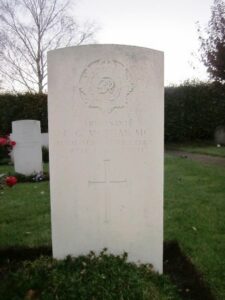
Gwyn Morgan, Private, 3910544, The Parachute Regiment. Gwyn was the son of Arthur and Margaret Morgan, of Loughor. He served with the 3rd Battalion, Parachute Regiment, Army Air Corps. The 3rd Parachute Battalion was formed in 1941, from volunteers from infantry regiments in the British Army, becoming part of the 1st Parachute Brigade, and later part of the 1st Airborne Division. The battalion first saw action during the Operation Torch landings, and during further operations in North Africa. Gwyn was killed in North Africa on 6 January 1943, aged 23. He is commemorated on the Medjez-El-Bab Memorial, Tunisia.
Ronald David Morgan, Sergeant, 1893132, Royal Air Force Volunteer Reserve. Ronald was the son of William David and Lilian May Morgan, of Loughor. He served as a Flight Engineer with 158 Squadron, Royal Air Force, which was a heavy bomber squadron equipped with the Handley Page Halifax, based at RAF Lissett. Ronald was killed in France on 18 July 1944, probably as the result of an aircraft crash. He was 20 years old and is buried in Banneville-La-Campagne War Cemetery, France.
Dennis George Niblett, Fusilier, 5735610, Royal Welch Fusiliers. Dennis was the son of George Harry and Clara Lillian Niblett, of Loughor. He served with the 4th Battalion, Royal Welch Fusiliers, which was attached to 158 Brigade, 53rd (Welsh) Division. The division landed in Normandy at the end of June 1944, and took part in the break out from Normandy. Dennis was killed during the attack on Evrecy on 17 July 1944, aged 19. He is buried in St. Manvieu War Cemetery, Cheux, France. Dennis is not commemorated on the Loughor War Memorial.
Emanuel John Pace, Leading Aircraftman, 961639, Royal Air Force Volunteer Reserve. Emanuel was the son of Joseph and Emily Pace, of Gorseinon. He served with the Royal Air Force, probably in 37 Squadron, which was a medium bomber squadron, equipped with the Vickers Wellington and based in the Middle East. Little is known of Emanuel, but he died on 21 August 1944, aged 22 and is buried in Naples War Cemetery, Italy.
John Humphrey Parry, Flight Sergeant, 1669977, Royal Air Force Volunteer Reserve. John was the son of Thomas Ivor and Hannah Parry, of Loughor. He served with 178 Squadron, Royal Air Force, which was equipped with Liberators at Shandur, Egypt on 15 January 1943. It moved to Libya, then Italy from March 1944, and was used for air drop operations in support of the besieged Polish Home Army in Warsaw in 1944. John was killed when his aircraft was brought down while taking supplies from Italy to Yugoslavia on 6 November 1944. He was 19 years old and is buried in Belgrade War Cemetery, Serbia.
Douglas Pewsey, Sergeant, 970469, Royal Air Force Volunteer Reserve. Douglas was the son of Thomas John and Margaret Ann Pewsey, of Loughor. He served with 44 Squadron, Royal Air Force, which was a bomber squadron, equipped with the Handley Page Hampden. On 14 November 1940, Douglas was a crewman aboard Hampden X2995, which took off from RAF Waddington to bomb targets on the continent. The aircraft stalled 800 feet off the ground and crashed a mile from the airfield, killing all her crew. Douglas was 21 years old, and was brought home for burial at Loughor (St. Michael) Churchyard.
Jacob Phillips, L.R.C.P., M.R.C.S, Lieutenant, 260690, Royal Army Medical Corps. Jacob was the son of Morris Lloyd Phillips and Elizabeth Jane Phillips, of Loughor. He trained as a Doctor prior to the war and was commissioned into the Royal Army Medical Corps on 13 February 1943. He embarked by train for Glasgow, and on 8 July 1943 sailed from Glasgow aboard HMS California, as part of Convoy Faith, bound for Freetown, Sierra Leone. On 11 July 1943 the convoy was about 300 miles west of Vigo, Spain, when it was attacked by three Focke-Wulf FW200 aircraft from Bordeaux. Jacob was among 46 men killed during the attack, which forced the Royal Navy to torpedo the California after the survivors had been rescued. Jacob was 28 years old when he was killed on 11 July 1943, and is commemorated on the Brookwood Memorial, Surrey. He is not commemorated on the Loughor War Memorial.
Lincoln Thomas Beynon Phillips, Sergeant, 1253989, Royal Air Force Volunteer Reserve. Lincoln was the son of Sidney and Edith Phillips, and the husband of Lilian Phillips, of Loughor. He served with 70 Squadron, Royal Air Force, which was a transport squadron, based in the Middle East, and equipped with the Vickers Wellington. Lincoln died in Egypt on 7 July 1942, aged 27. He is buried in Ismailia War Memorial Cemetery, Egypt. Lincoln is not commemorated on the Loughor War Memorial.
David Eynon Powell, Aircraftman 2nd Class, 1417071, Royal Air Force Volunteer Reserve. David was the son of Daniel and Mary Jane Powell, of 35, Lime Street, Gorseinon. He married Catherine Ada Beynon, of Loughor, in 1933. David enlisted into the Royal Air Force. He died on active service at Farnworth, Lancashire on 25 February 1942, aged 33, and is buried in Kingsbridge Cemetery, Glamorgan. David is not commemorated on the Loughor War Memorial.
Leslie Allen Pritchard, Ordinary Seaman, D/JX 168621, Royal Navy. Leslie was born in Loughor on 7 January 1919 and served with the Royal Navy, aboard the aircraft carrier HMS Glorious, which had originally been built in 1915 as a Battlecruiser, but was later modified into an aircraft carrier in 1924, by removing all of her upper deck components. On 24 April 1940, Glorious and HMS Ark Royal sailed for Norway, to aid the British attempt to defend the country from German attack. She made several trips to Norway, bringing Gloster Gladiators and Hurricanes to aid in the defence of the country, but on 5 June 1940 the British began to evacuate Norway, and Glorious loaded up with aeroplanes and headed back to Scapa Flow. However on 8 June the carrier and her two escorts, the destroyers HMS Acasta and HMS Ardent, were intercepted by the German battleships Scharnhorst and Gneisenau. The carrier and her escorts were sunk in two hours, roughly 280 nautical miles (510 km) west of Harstad. Leslie was 21 years old when he died aboard HMS Glorious on 8 June 1940. He is commemorated on Panel 39 of the Plymouth Naval Memorial, Devon.
Elwyn Rees, Stoker 1st Class, D/KX 110956, Royal Navy. Elwyn was the son of Gronow and Mary H. Rees and the husband of Beatrice Doreen Rees. He served with the Royal Navy aboard HMS Hecla. Hecla was a Destroyer Depot Ship launched in March 1940 and was operating in the Mediterranean during the Allied landings, when she was sunk off Casablanca on 12 November 1942 by U-515 with the loss of 279 of her crew. Elwyn was 26 years old when he died that day and is commemorated on Panel 70 of the Plymouth Naval Memorial, Devon.
Elvet Richards, Driver, T/3971207, Royal Army Service Corps. Elvet was the son of Charles and Mary Richards, and the husband of Nancy Richards, of Loughor. He had served with the Royal Army Service Corps during the war. Little is presently known of him, but Elvet died at Swansea on 24 June 1947, aged 26, and is buried in Penclawdd (Parc Hendy) Cemetery. He is not commemorated on the Loughor War Memorial.
Reginald Gordon Richards, Aircraftman 1st Class, 635445, Royal Air Force. Reginald, known as Gordon, was the son of John James Richards and Elizabeth Rachel Richards, of Gorseinon. He served with the Royal Air Force in the far east, either with the Singapore garrison or somewhere else in Malaysia. Reginald was among about fifty RAF servicemen who died on 15 February 1942, the day that the Singapore Garrison surrendered to the Japanese. He was 21 years old and is commemorated on the Singapore Memorial, Singapore.
Arthur Clifford Rogers, Private, 14784563, Welch Regiment. Arthur was born in Swansea in 1915. He served with the 4th Battalion, Welch Regiment, which was the local Territorial unit, attached to the 53rd (Welsh) Division. The division spent much of the war stationed in Northern Ireland and the south of England before landing in Normandy at the end of June 1944, in order to take part in the break-out from the beach-head. It saw heavy fighting in Normandy and in the subsequent advance through northern France through Belgium and Holland into Germany. Arthur was killed in action during an attack by the 4th Welch upon strong German defensive positions around Alpon on 7 March 1945, when the battalion came into contact with elite German paratroopers who were attempting to slow the British advance in order for German troops to be withdrawn across the Rhine. Arthur was 30 years old and is buried in Reichswald Forest War Cemetery, Germany.
Harry Skippon, Civilian. Harry was the son of Robert and Mary Skippon, of 10 Boro Road, Loughor. He worked at the Bristol Aeroplane Works, at Filton, and lived at 13 Douglas Road, Horfield, Bristol. Harry was killed during a devastating air raid on the works on 25 September 1940, aged 32. His death was registered by Sodbury, Rural District, but the location of his grave is presently unknown. Harry is not commemorated on the Loughor War Memorial.
Arthur Smith, Stoker 2nd Class, D/KX 122347, Royal Navy. Arthur was born in Gorseinon on 28 January 1916. He served in the Royal Navy at HMS Sultan, which was the Shore Base for the Royal Navy at Singapore at the outbreak of war. Many of the crew of HMS Sultan were survivors of the Force Z catastrophe, the crews of HMS Repulse and HMS Prince of Wales. Arthur was killed on 16 February 1942, aged 26, and is commemorated on the Plymouth Naval Memorial, Devon.
James Smith. This man cannot presently be identified.
James Stuart, Civilian. James was the son of George and Mary Ann Stuart, of Sea View, Castle Street, Loughor, and the husband of Martha Stuart, of 20 Fabian Street, St. Thomas. He died at Manselton Road, Manselton during an air raid on 20 February 1941, aged 33. His death was registered by Swansea, County Borough, but the location of his grave is not known. He is not commemorated on the Loughor War Memorial.
Albert John Thomas, Sergeant, 1006925, Royal Air Force Volunteer Reserve. Albert was the son of James and Ellen Beatrice Thomas, and the husband of Beryl Thomas, of Loughor. He served with 40 Squadron, Royal Air Force, which was a medium bomber squadron, equipped with the Vickers Wellington, based at RAF Wyton. Albert was killed when his Wellington was lost over Nuremberg on 15 October 1941. He was 25 years old and is commemorated on the Runnymede Memorial, Surrey.
David Glynn Thomas, BA, Captain, Royal Marines. David was the son of John and Caroline Thomas, of Loughor. He married Elinor Annie Adams, of Loughor in 1942. David had graduated with BA (Honours) prior to the war, and was commissioned into the Royal Marines. He served with 602 Landing Craft (Mechanised) Flotilla. On 25 June 1944 David was aboard the SS Cap Tourane, which was anchored off Sword Beach, being used as the HQ ship, when the ship was hit by a German shell. David and a fellow officer were killed. David was 31 years old, and is buried in Hermanville War Cemetery, France. He is not commemorated on the Loughor War Memorial.
Gerwyn John Thomas, Private, 14339540, Queen’s Own Royal West Kent Regiment. Gerwyn was the son of Joseph and Annie Thomas, of Loughor. He served with the 6th Battalion, Queen’s Own Royal West Kent Regiment. The 6th Battalion was part of the 78th Infantry Division and took part in the Tunisian Campaign. It then took part in the invasion of Italy in 1943. Gerwyn was killed in Italy on 18 November 1944, aged 21. He is buried in Faenza War Cemetery, Italy. Gerwyn is not commemorated on the Loughor War Memorial.
Meirion Thomas. This man cannot presently be identified as only one man of that name is recorded as being a WW2 casualty, and he appears to have been from Harlech.
Owen Goronwy Thomas, Leading Writer, D/MX 105408, Royal Navy. Owen was born in Loughor in 1908, the son of Thomas and Elizabeth Thomas. His parents moved to Martley, Llandyssul at some time after the war. Owen married Doris Cordelia Morris of Llanelly in 1936. He enlisted into the Royal Navy and served aboard the Dido Class destroyer HMS Charybdis. She was sent to sea in the English Channel on 23 October 1943 as part of a number of vessels to intercept the German supply ship Munsterland. Charybdis was attacked and sunk by a squadron of German torpedo boats that day, with the loss of over 400 men. Owen was 35 years old, and is remembered on the Plymouth Naval Memorial, Devon. He is not commemorated on the Loughor War Memorial.
Thomas James Glyndwr Thomas, Flight Sergeant, 615005, Royal Air Force. Thomas was the son of William and Nellie Thomas, of Loughor, and the husband of Elizabeth Doreen Thomas, of Gorseinon. He served with the Royal Air Force as a Wireless Operator/ Air Gunner. Thomas was killed on 14 January 1943 while flying aboard Handley Page Halifax W7844, which lost control and crashed while on a training flight near Kemble, Gloucestershire. He was 24 years old, and is buried in Kingsbridge Cemetery, Glamorgan.
Urien Thomas, Sergeant, 1286345, Royal Air Force Volunteer Reserve. Urien was the son of William Henry and Annie Jane Thomas, of Loughor. He served with 156 Squadron, Royal Air Force, which was an elite Pathfinder unit of Bomber Command. William was an experienced crewman, who had flown in fourteen missions over Germany. His fifteenth mission took place on the night of 26 March 1943 when he flew off from RAF Worboys aboard Lancaster W4895, bound for Berlin. On the morning of 27 March 1943 the Lancaster crashed into the ground near Doberlitz, killing all her crew, including Urien, who was 21 years old. The six crewmen were originally buried locally, but were re-interred after the war in the Berlin 1939-1945 War Cemetery, Germany.
Kenneth John Lewis Waldron, Signalman, 2585082, Royal Corps of Signals. Kenneth was the son of William and Alice Waldron. He married Phyllis Thomas, of Loughor, in 1939. Kenneth enlisted into the Royal Corps of Signals, and was posted to the 44th Division Signals. The division was evacuated from Dunkirk in 1940, and was sent to North Africa after rebuilding. It took part in the Battle of Alam Halfa and the Second Battle of El Alamein. Kenneth was killed at El Alamein on 4 September 1942, aged 25. He is buried in El Alamein War Cemetery, Egypt. Kenneth is not commemorated on the Loughor War Memorial.
Philip William Williams, Warrant Officer, 1375918, Royal Air Force Volunteer Reserve. Philip was the son of Watkin and Annie Williams, of Loughor. He served with 353 Squadron, Royal Air Force, which had been formed at Dum Dum, India on 1 June 1942. Philip was killed in an aircraft accident at Dehanu, Bombay on 17 August 1945, aged 32. He is buried in Kirkee War Cemetery, India. Philip is not commemorated on the Loughor War Memorial.
John Leslie Woodward, Driver, T/179934, Royal Army Service Corps. John was the son of John Solomon Woodward and Mary Woodward (nee Hughes), of Gorseinon. He originally served with the Royal Army Service Corps, and had been posted overseas to serve with the 23rd Light Anti Aircraft Regiment, Royal Artillery, which was in Burma. John became ill and died of peritonitis aboard ship while en-route to India on 11 July 1942, aged 28. He is buried in Madras War Cemetery, Chennai, India.
